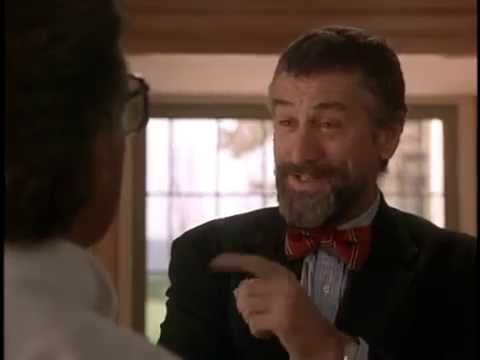In the world of political satires, few films manage to hit the mark as sharply as “Wag the Dog.” Released in the late 90s, this film offers a biting and humorous look at the lengths political operatives will go to manipulate public opinion. As relevant today as it was then, its exploration of media manipulation and political engineering feels eerily prophetic.
“Wag the Dog” stars Dustin Hoffman and Robert De Niro, whose performances bring a dynamic energy to the screen, perfectly capturing the cynicism and machinations of their characters. The film’s clever script and brisk pacing make it a standout in the genre, inviting viewers to ponder the realities behind the presented fiction. Join us as we dive into this masterful blend of comedy and commentary, unpacking its continued relevance in today’s media-saturated political landscape.
Overview of Wag the Dog
“Wag the Dog” is a sharp political satire that dives deep into the intricacies of media manipulation in politics. Directed by Barry Levinson and released in 1997, this film continues to resonate with viewers due to its alarmingly prescient take on the power of spin doctors and the complacency of the electorate. With a star-studded cast led by Robert De Niro and Dustin Hoffman, the movie excels in delivering a potent mix of humor and dark political commentary.
The storyline follows a spin doctor and a Hollywood producer as they concoct a fake war to distract the public from a presidential scandal. This premise lays the groundwork for a series of comedic yet thought-provoking scenarios that explore the manipulation of public perception and the blurring lines between reality and media creation. The film’s brisk pacing and clever script, peppered with satirical stings and witty dialogues, keep the audience engaged from start to finish.
As the film unfolds, viewers are treated to Hoffman’s portrayal of the eccentric producer and De Niro’s calculating political strategist, both of whom masterfully navigate the chaotic world they’ve spun. The chemistry between the leads, combined with Levinson’s tight direction, creates a cinematic experience that is both entertaining and unsettling, making “Wag the Dog” a significant commentary on the state of political media. This section examines how “Wag the Dog” uses humor to critique political maneuvers and media influence, setting a high mark for political comedies that few films have reached since.
Plot Summary
“Wag the Dog” unfolds with a riveting premise where a spin doctor, Conrad Brean (played by Robert De Niro), is hired just days before a presidential election to divert the public’s attention from a scandalous incident involving the President. Recognizing the enormity of the challenge, Brean enlists the expertise of flamboyant Hollywood producer Stanley Motss (portrayed by Dustin Hoffman) to fabricate a faux conflict in Albania.
The plot thickens as they craft a narrative involving a war that doesn’t exist, complete with a theme song, a patriotic slogan—”Don’t Change Horses in Midstream”—and a heart-wrenching image of an orphaned girl fleeing from the chaos. As the scheme gains traction, media outlets unknowingly promote this nonexistent war, illustrating the power and influence of mass media manipulation.
Throughout the film, the duo navigates close calls and complex scenarios, including staging footage of a young American soldier (portrayed by Woody Harrelson) heroically escaping captivity. Each twist in their plot is more audacious than the last, blending dark comedy with a shocking insight into the mechanics behind political maneuvering and public deception.
The narrative raises critical questions about reality, media ethics, and the gullibility of the electorate, maintaining a sharp, satirical edge. As events spiral, the line between truth and fiction becomes increasingly blurred, leading to an unforgettable climax that underscores the film’s message about the potent mix of politics, media, and entertainment.
Features
In “Wag the Dog,” diverse elements meld together to create a compelling satirical narrative that remains impactful over two decades later. Below, we delve into the specifics of the acting, direction, cinematography, and the script, each of which plays a crucial role in amplifying the film’s thematic concerns and overall entertainment value.
Acting and Cast Performance
“Wag the Dog” boasts an impressive ensemble, but it’s the dynamic performances of Dustin Hoffman and Robert De Niro that stand out. Hoffman, playing flamboyant producer Stanley Motss, injects a vibrant charisma and desperation into his role, perfectly complementing De Niro’s portrayal of the cunning spin doctor, Conrad Brean. Their chemistry is palpable, driving the film’s narrative forward with both tension and humor. The supporting cast also adds depth and nuance, with Anne Heche, Denis Leary, and Willie Nelson delivering performances that impeccably balance the line between satire and realism.
Direction and Cinematography
Barry Levinson’s direction in “Wag the Dog” is both precise and impactful, allowing the film to explore complex themes with a light yet poignant touch. His ability to handle satire without losing the undercurrents of tension in the storyline is notable. Cinematographically, the film employs a straightforward style that serves the narrative without becoming distracting. It’s Levinson’s directorial choices—particularly the use of close-ups and quick cuts—that intensify the urgency of the film’s fictional crisis, keeping viewers engaged and emphasizing the constructed nature of the media spectacle within the story.
Script and Dialogue
The script of “Wag the Dog” is sharp and meticulously crafted. The dialogue, written by David Mamet and Hilary Henkin, crackles with Mamet’s characteristic rapid-fire wit, making it both a critical and audience favorite. It cleverly critiques the symbiosis between media and politics through incisive humor and memorable lines that echo long after the movie ends. The script not only questions the ethics of media manipulation but also serves as a reflection on the gullibility of the public, making its commentary as relevant today as it was at the time of release.
User Experience
“Wag the Dog” offers more than just a plot to ponder; it provides a riveting experience that leaves a lasting impression on its audience. Below, we delve into the various aspects that significantly enhance the viewer’s journey through the movie.
Emotional Impact
The emotional resonance of “Wag the Dog” is palpable, largely driven by its compelling narrative and the exceptional performances from its cast. As viewers witness the unethical manipulation of media to create a fake war, they experience a range of emotions from disbelief to dismay. This rollercoaster is punctuated by moments of tension between Conrad Brean and Stanley Motss, which are masterfully executed by De Niro and Hoffman. Their portrayal exposes the audience to the stark realities of political maneuvering, leaving them to question the authenticity of real-world media narratives. The film cleverly intertwines these serious themes with its comedic elements, ensuring that viewers are entertained while simultaneously feeling unease about the depicted manipulations, thus anchoring the film’s message more deeply into their consciousness.
Humor and Satire Quality
The quality of humor and satire in “Wag the Dog” is a critical element of its success and enduring appeal. The film uses sharp wit and fast-paced satire to critique political and media ethics, making substantial points through laughter and irony. The dialogue, crafted with David Mamet’s characteristic snap, delivers lines that are not only memorable but also thought-provoking, highlighting the absurdity of the political landscape. The dynamic between Hoffman’s flamboyant producer and De Niro’s cynical spin doctor adds a humorous tension that keeps the audience engaged and amused. This satirical approach does not merely serve as entertainment but as a compelling commentary on the absurdity of political spins. The humor resonates because it mirrors realities in the political world, making the satire both hilarious and somewhat sobering.
Pros
“Wag the Dog” stands as a shining example of political satire done right, capturing audiences with its sharp wit and critical eye. Let’s delve into the aspects that make this film a must-watch.
Engaging Storyline
The plot of “Wag the Dog” is not only original but also eerily prescient, reflecting real-world political tactics that seem all too familiar in today’s landscape. The concept of creating a fake war to distract from a presidential scandal is both absurd and plausible, providing a perfect setup for satire. The film escalates smoothly, keeping viewers hooked with constant twists and compelling them to question the authenticity of media reports and the transparency of political maneuvers. The speed at which the fake news is created and accepted by the public in the film serves as a chilling reminder of the power of misinformation. This engaging storyline not only entertains but also educates by illuminating the often-manipulative nature of media and political strategy.
Strong Performances
Dustin Hoffman and Robert De Niro deliver performances that are both dynamic and nuanced, driving the film with their chemistry and charisma. Hoffman, as Stanley Motss, captures the flamboyance and egotism of a Hollywood producer with precision, while De Niro’s portrayal of Conrad Brean, the cynical spin doctor, is a masterclass in understated, strategic acting. Their interactions provide much of the film’s comedic relief but also highlight the underlying tension of their deceitful undertaking. These performances not only underline the actors’ versatility but also enhance the film’s impact by fostering a deeper connection with the audience. The convincing portrayal of their characters ensures that the viewers are invested in the storyline, regardless of its absurdity, making the film’s message more impactful.
Cons
While “Wag the Dog” delivers a biting critique of media and political machinations, a few aspects of the film may not resonate as well with every viewer. Below, we delve into the potentially contentious themes and some criticisms concerning the film’s pacing.
Controversial Themes
“Wag the Dog” unabashedly explores themes that might be polarizing for certain audiences. The film’s central premise of manipulating public perception through fake news can be seen as a satirical take, yet it treads on ethical boundaries that might discomfort viewers who find the notion of such deep deceit in political realms unsettling. This portrayal of unethical media practices, aimed at critiquing them, might also be misconstrued as trivializing serious real-world issues about truth and media integrity. For viewers sensitive to the manipulative tactics of politics and media, the film’s flippant treatment of these could come off as cynical to the point of nihilism, potentially alienating those who prefer their political commentaries to carry a more hopeful or constructive tone.
Pacing Issues
Some viewers might find the film’s pacing irregular. While “Wag the Dog” is generally praised for its brisk pacing, there are segments in the middle where the narrative seems to stall—particularly as it revels in the minutiae of the fake war creation. These sections, intended to build tension and deepen the satirical elements, might instead slow the momentum of the plot for those accustomed to more consistently fast-paced storytelling. This fluctuation in tempo can lead to a viewing experience that feels uneven, potentially reducing the impact of the film’s climax by diluting the build-up with protracted scenes that might not add significant value to the central narrative.
Comparison
“Wag the Dog” shines as a political satire through its vivid depiction of media manipulation, but how does it stack up against other films in the genre? Here, we compare it to other notable political comedies, exploring different approaches to humor and critique in politics.
Alternatives in Political Comedy
When considering other political comedies, films like “Dr. Strangelove” by Stanley Kubrick and “The Dictator” starring Sacha Baron Cohen provide interesting contrasts to “Wag the Dog.”
Dr. Strangelove or: How I Learned to Stop Worrying and Love the Bomb (1964) skillfully blends political satire with black comedy to critique Cold War paranoia and the absurdity of nuclear strategies. Unlike the direct and somewhat on-the-nose fabrications of “Wag the Dog,” Kubrick’s film uses exaggerated characters and surreal scenarios to highlight the folly in government and military mechanisms, leaving a lasting impression on its audience with its iconic visual and verbal wit.
The Dictator (2012), on the other hand, uses a more direct and crass form of humor to poke fun at the ludicrousness of authoritarian regimes. Sacha Baron Cohen’s portrayal of a despotic North African dictator offers slapstick, shock humor, and ironic commentary, differing from “Wag the Dog”’s subtler satirical style. While “Wag the Dog” utilizes a realistic approach that could conceivable unfold behind closed doors, “The Dictator” amplifies its comedic effect through unlikely and outrageous scenarios.
Both films serve as compelling alternatives, each using different methods to engage with political themes, demonstrating the versatility and depth of the political comedy genre. Yet, “Wag the Dog,” with its sharp, fast-paced script and stellar performances, holds a unique place for its compelling narrative about the power of media manipulation in shaping public perception. It offers a more grounded form of satire that resonates deeply in today’s media-driven society, reflecting ongoing concerns about the influence of fake news and political public relations, thus making its commentary ever relevant in the current political climate.
Testing
As “Wag the Dog” navigates the nuanced realms of political satire and media manipulation, evaluating its impact on viewers and critics alike provides insight into its success and relevance. This section explores audience reactions and ratings, which serve as vital indicators of the film’s resonance and reach.
Viewer Reactions and Ratings
“Wag the Dog” has incited a broad spectrum of responses from its audience, ranging from admiration for its sharp wit to discomfort over its unsettling themes. Viewer feedback highlights a general appreciation for the film’s clever execution and the compelling performances of its lead actors. Audiences have praised the film for its ability to blend serious political critiques with humor, maintaining a delicate balance that keeps the viewer engaged while also prompting them to reflect on the issues presented.
Ratings from major film review platforms reflect the film’s overall approval. On IMDb, “Wag the Dog” holds a solid score, indicative of its favorable reception among a diverse audience. This rating is supported by the viewer comments that often commend the film for its thought-provoking content and timely relevance, considering ongoing discussions about media integrity and fake news. Rotten Tomatoes presents a similar picture, with the film achieving a high approval rating from both critics and audiences, underscoring its success as a political satire that still strikes a chord today.
On social media platforms and online forums, discussions about “Wag the Dog” reveal a mix of interpretations. Some viewers express a profound appreciation for the film’s insightful commentary on the media’s role in shaping public perception, while others critique its occasionally heavy-handed approach to delivering its message. This polarization is typical for films in the political satire genre, which often evoke strong and varied reactions due to the sensitive nature of their content.
Analysis of viewer reactions and ratings confirms that “Wag the Dog” continues to be a significant film in the realm of political satire. Its ability to incite dialogue and debate among its viewers highlights its enduring impact and the effectiveness of its message.
Conclusion
“Wag the Dog” stands as a masterful exploration of media manipulation and political machinations. Its sharp wit and dynamic performances make it a compelling watch that resonates with viewers even decades after its release. The film not only entertains but also provokes thought challenging the audience to discern reality from manipulation in a media-saturated world. Whether one views it as a humorous jaunt through political strategy or a sobering peek behind the curtain of media influence it’s clear that “Wag the Dog” continues to be relevant in our current political climate. Its legacy as a poignant political satire is well cemented offering both a laugh and a lesson making it a must-watch for those intrigued by the intersections of media politics and public perception.



 RELATED POSTS
RELATED POSTS





0 Comments